 |
416th Bombardment Group (L) A-26 Training and ETO Combat Evaluation Aircraft
|
 |
Return to Table of Contents
 |
416th Bombardment Group (L) A-26 Training and ETO Combat Evaluation Aircraft
|
 |
The May 18, 1944 "Memorandum for Deputy Chief of the Air Staff (Brigadier General Timberlake)", "Subject: Introduction of A-26 Aircraft to the European Theatre" document #64 (included in the "Case History of A-26 Airplane") details the request for eighteen (18) A-26's (proportion of 1/3 (6) bombardier (glass) nose (A-26C), 2/3 (12) gun (solid) nose (A-26B)), giving rise to the common belief that only 18 Invaders were used in the ETO Combat Evaluation. However, due to accidents or other reasons which eliminated some A/C from service, 24 Invaders have been identified as being sent overseas for participation in the ETO Combat Evaluation and subsequent Conversion Training.
The following Douglas A-26 Invaders have been identified as being associated with State-side A-26 Training, the European Theatre of Operations (ETO) Combat Evaluation Project and subsequent A-26 Conversion Training of the 416th Bomb Group.
There may be additional A-26s used, but these are aircraft for which there is evidence of involvement.
The first 3 Aircraft listed below were involved in A-26 training accidents in the USA and were not sent overseas; the remaining 24 were sent to the ETO.
Of the 24 Invaders sent to the ETO for the Combat Evaluation Project and/or Conversion Training, 4 were A-26C (bombardier/glass nosed) models (41-39193, 41-39195, 41-39199 and 41-39200), the remaining 20 were A-26B (gun/solid nosed) models. One Invader, 43-22286, was built at the Douglas Tulsa ("DT") plant in Tulsa, Tulsa County, Oklahoma; all others at the Douglas Long Beach ("DL") plant in Long Beach, Los Angeles County, California.
All but 4 of these planes sent overseas departed the USA from Dow Field, Bangor, Maine. The first 4 Invaders sent to England were Aircraft 41-39132 which departed from Wright Field, Dayton, Ohio and Invaders 41-39143, 41-39145 and 41-39146 which departed from Grenier Field, Manchester, New Hampshire. It is likely all the ETO Combat Evaluation Aircraft flew to England via the "Northern Ferry Route" (Canada, Greenland, Iceland and the United Kingdom).
Based on information from the Individual Aircraft Record Cards (IARC), these aircraft did not arrive in England in one large group, but rather over a period of two months.
- 4 Invaders arrived in the ETO in July 1944 -- 41-39132, 41-39145 and 41-39146 on 8-Jul-1944 and 41-39143 arrived 22-Jul-1944 (this plane was the one which led the flight of 9 planes from Nutts Corner to Great Dunmow). It is not certain if these four airplanes were initially assigned at Great Dunmow or other bases.
- Most of the Combat Evaluation A-26s arrived in August 1944 in two groups -- 7 aircraft (41-39183, 41-39185, 41-39190, 41-39191, 41-39194, 41-39198, 41-39199) on August 13th and 14th, and 8 more on 24-Aug-1944 (41-39187, 41-39189, 41-39193, 41-39196, 41-39197, 41-39200, 41-39201, 41-39202) (see landing mishap described above).
- The remaining 5 Invaders arrived in the ETO in September 1944: 41-39206 and 43-22286 on the 8th, 41-39195 on the 13th, 41-39186 and 41-39207 both on 18-Sep-1944; the latter two A/C arriving too late to fly on the Combat Evaluation Missions from Great Dunmow, but were used in A-20 to A-26 conversion training for the 416th Bomb Group.
On most WWII era documents, individual Aircraft are indentifed by a 3-digit "A/C Number" or just "A/C". This number is actually the last 3 digits of the USAAF A/C Serial Number. Both Identifiers are included below.
| A/C Number |
A/C Serial Number |
Model | Notes |
|---|---|---|---|
| 121 | 41-39121 | A-26B-10-DL | 27 June 1944 Belly Landing due to a malfunction of the landing gear locking mechanism, AAR-44-6-27-63 |
| 253 | 43-22253 | A-26B-5-DT | 11 July 1944 Fatal crash landing, AAR-45-7-11-25 |
| 254 | 43-22254 | A-26B-5-DT | 18 July 1944 Non-Flying accident, Nose gear collapsed, AAR-45-7-18-11 |
| A/C Number |
A/C Serial Number |
Model | Fuselage Code | ETO Evaluation Missions |
USA Departure Date |
ETO Arrival Date |
Notes |
|---|---|---|---|---|---|---|---|
| 132 | 41-39132 | A-26B-10-DL | AN-P | 1 (Abort), 2?, 5, 8-Extra | 23-Jun-1944 | 8-Jul-1944 | One of the first A-26's in the ETO. |
| 143 | 41-39143 | A-26B-15-DL | None | None | 12-Jul-1944 | 22-Jul-1944 | Per AAR-45-8-24-540: This Aircraft was already in the ETO and led a flight of 9 from Nutts Corner, North Ireland to Great Dunmow, the other 8 A/C having recently arrived at Nutts Corner from the USA. This A/C landed First, slid off the end of the runway and was subsequently struck by 41-39193 after landing on arrival at 386th BG Great Dunmow 24-Aug-1944. This Aircraft was Damaged Beyond Repair as noted by Bauguer ("DBR"), thus did not fly on any of the 8 A-26 ETO Combat Evaluation Missions. |
| 145 | 41-39145 | A-26B-15-DL | None | None | 28-Jun-1944 | 8-Jul-1944 | One of the first A-26's in the ETO. Aug 30, 1944 - AAR-45-8-30-522 - Take-off Accident, Pilot's mission: Local test hop. 553rd BS, 386th BG. Oct 19, 1944 - AAR-45-10-19-528 - "(MSN 6858, 668th BS, 416th BG) in landing accident at Melun Villaroche airfield A-55 Seine-et-Marne, France Oct 19, 1944. All 3 crew survived. Aircraft badly damaged, unknown if repaired." (Baugher). |
| 146 | 41-39146 | A-26B-15-DL | AN-Q ? | 4, 7?, 8 | 28-Jun-1944 | 8-Jul-1944 | One of the first A-26's in the ETO. |
| 183 | 41-39183 | A-26B-15-DL | AN-B | 1, 2, 3, 6, 7, 8 | 4-Aug-1944 | 13-Aug-1944 | 15-Oct-1944 - AAR-45-10-15-536 - Nose gear collapse. |
| 185 | 41-39185 | A-26B-15-DL | AN-H | 1, 2, 3, 4,5 | 4-Aug-1944 | 13-Aug-1944 | 12-Sep-1944 - AAR-45-9-12-529 - taxi accident between 41-39185 and 41-39190. |
| 186 | 41-39186 | A-26B-15-DL | AN-W | None | 14-Aug-1944 | 18-Sep-1944 | This A/C did NOT fly A-26 ETO Combat Evaluation Missions from Great Dunmow in September 1944 (it arrived in the ETO on 18-Sep-1944). Photo shows Fuselage Code "AN-W". This A/C was used in the 416th BG A-20 to A-26 conversion training. |
| 187 | 41-39187 | A-26B-15-DL | AN-O | 1, 2, 3, 5, 6, 7, 8 | 9-Aug-1944 | 24-Aug-1944 | Per AAR-45-8-24-540: One of 8 A/C ferried from USA, last leg from Nutts Corner, North Ireland landing at Great Dunmow 24-Aug-1944. |
| 189 | 41-39189 | A-26B-15-DL | AN-N | 1, 2, 3, 4, 5, 6, 7?, 8 | 18-Aug-1944 | 24-Aug-1944 | Per AAR-45-8-24-540: One of 8 A/C ferried from USA, last leg from Nutts Corner, North Ireland landing at Great Dunmow 24-Aug-1944. |
| 190 | 41-39190 | A-26B-15-DL | AN-A | 1, 2, 3, 5, 8 | 4-Aug-1944 | 13-Aug-1944 | 12-Sep-1944 - AAR-45-9-12-529 - taxi accident between 41-39185 and 41-39190. |
| 191 | 41-39191 | A-26B-15-DL | AN-G | 1, 2, 3, 5, 6, 7, 8 | 4-Aug-1944 | 13-Aug-1944 | |
| 193 | 41-39193 | A-26C-2-DL | None | None | 14-Aug-1944 | 24-Aug-1944 | Per AAR-45-8-24-540: One of 8 A/C ferried from USA, last leg from Nutts Corner, North Ireland landing at Great Dunmow 24-Aug-1944. This A/C landed fourth and crashed into 41-39201 and then crashed into 41-39143 on arrival landing at 386th BG Great Dunmow 24-Aug-1944. NOTE, AAR report shows A-26B, but Baugher and Aircraft Record Card show this as an A-26C. This Aircraft was Damaged Beyond Repair as noted by Bauguer ("DBR"), thus did not fly on any of the 8 A-26 ETO Combat Evaluation Missions. |
| 194 | 41-39194 | A-26B-15-DL | AN-C | 1, 2?, 3, 4, 5, 6, 7?, 8 | 7-Aug-1944 | 13-Aug-1944 | |
| 195 | 41-39195 | A-26C-2-DL | AN-T | 8 | 21-Aug-1944 | 13-Sep-1944 | AAR-45-8-24-540 shows A/C 195 safely landing 5th out of 9, but the IARC shows it did not arrive in the ETO until 13-Sep-1944 and it only flew the 8th Combat Evaluation mission on 19-Sep-1944, so AAR number "195" is likely incorrect, and is most likely 197 (41-39197) instead. |
| 196 | 41-39196 | A-26B-15-DL | AN-J | 1, 2, 3, 4, 5, 6-Extra, 7, 8 | 12-Aug-1944 | 24-Aug-1944 | Per AAR-45-8-24-540: One of 8 A/C ferried from USA, landing at Great Dunmow 24-Aug-1944, Landed second (after 41-39143). Crash 15-Oct-1944 - AAR-45-10-15-533 - Midair collision and crashed near Sezanne, France. Total loss, all 3 crew members perished. |
| 197 | 41-39197 | A-26B-15-DL | AN-M | 1, 2, 3, 4, 5-Extra, 6, 7, 8 | 12-Aug-1944 | 24-Aug-1944 | Per AAR-45-8-24-540: One of 8 A/C ferried from USA, last leg from Nutts Corner, North Ireland landing at Great Dunmow 24-Aug-1944, possibly Landing fifth (AAR shows A/C # 195, but 195 is incorrect and is most likely 197 (41-39197)). |
| 198 | 41-39198 | A-26B-15-DL | AN-F | 1, 2, 3, 4, 5, 6, 7 | 7-Aug-1944 | 14-Aug-1944 | |
| 199 | 41-39199 | A-26C-2-DL | AN-D | 1, 2, 3, 4, 5, 6, 7, 8 | 9-Aug-1944 | 13-Aug-1944 | |
| 200 | 41-39200 | A-26C-2-DL | AN-L | 1, 2, 4, 5, 6, 7, 8 | 18-Aug-1944 | 24-Aug-1944 | Per AAR-45-8-24-540: One of 8 A/C ferried from USA, last leg from Nutts Corner, North Ireland landing at Great Dunmow 24-Aug-1944. |
| 201 | 41-39201 | A-26B-20-DL | None | None | 14-Aug-1944 | 24-Aug-1944 | Per AAR-45-8-24-540: One of 8 A/C ferried from USA, last leg from Nutts Corner, North Ireland landing at Great Dunmow 24-Aug-1944, Landed third (after 41-39196) and slid off the right side of the runway. This A/C was struck by 41-39193 after landing on arrival landing at Great Dunmow and was Damaged Beyond Repair as noted by Bauguer ("DBR"), thus did not fly on any of the 8 A-26 ETO Combat Evaluation Missions. |
| 202 | 41-39202 | A-26B-20-DL | AN-K | 1, 2, 3, 4, 6, 7, 8 | 17-Aug-1944 | 24-Aug-1944 | Per AAR-45-8-24-540: One of 8 A/C ferried from USA, last leg from Nutts Corner, North Ireland landing at Great Dunmow 24-Aug-1944. |
| 206 | 41-39206 | A-26B-20-DL | AN-R | 2?, 3, 4, 5, 6, 7, 8 | 27-Aug-1944 | 8-Sep-1944 | IARC ETO Arrival Date is partially cut-off, estimate 8-Sep-1944. |
| 207 | 41-39207 | A-26B-20-DL | AN-V | None | 21-Aug-1944 | 18-Sep-1944 | This A/C did NOT fly A-26 ETO Combat Evaluation Missions from Great Dunmow in September 1944 (it arrived in the ETO on 18-Sep-1944), but it was used in the 416th BG A-20 to A-26 conversion training. Per Cachat Plane Crashes and AAR-45-10-28-530: Oct 18, 1944 A-26B-20-DL, 41-39207, AN-V Project Squadron (attached to the 386 BG, 553 BS) A/C used for A-20 to A-26 transition training of the 416th. "(669th BS, 416th BG) in taxi accident at Melun Villaroche Airfield A-55 Seine-et-Marne, France. All three crew survived. Aircraft badly damaged, not known if repaired." (Baugher). AAR shows Call Letter is "V". |
| 286 | 43-22286 | A-26B-10-DT | AN-S ? | 2?, 3, 4, 6, 7?, 8 | 26-Aug-1944 | 8-Sep-1944 | 3-digit AirCraft # "286" is S/N 43-22286, NOT 41-39286. The 41-39286 IARC shows A/C 41-39286 did not arrive in ETO until between 31-Oct-1944 and 27-Dec-1944, so it CANNOT be the S/N flying these missions in September, 1944. NOTE: This A/C (43-22286) arrived in the ETO on 8-Sep-1944 so it was the Aircraft flying on A-26 ETO Combat Evaluation Mission #2 (10-Sep-1944) and later. |
| Date | Report | A/C Serial # Type |
Mis- sion # |
Bomb Sq |
Location | Personnel (Status when available) | |
|---|---|---|---|---|---|---|---|
| Oct 15, 1944 Sunday |
AAR 45-10-15-536 |
41-39183 A-26B |
670 | 2 Miles North of Deulair, France | Sheley, Stanley Horace (Not injured)
Paladino, Domenic V. (Not injured) Tharp, Freeland M. (Not injured) |
||
| Oct 15, 1944 Sunday |
AAR 45-10-15-533 |
41-39196 A-26B |
670 | 8 1/2 miles SW of Sezanne, France | Leishman, Samuel Payne (Fatal)
Siracusa, Joseph F. (Fatal) Shempren, Eugene H. (Fatal) |
||
| Oct 16, 1944 Monday |
AAR 45-10-16-517 |
41-3380 A-20B |
670 | RAF Airfield, Southend, England | Jackson, Chester Ronald (Not injured)
Maltby, Alfred H. (Not injured) Burns, Donald E. (Not injured) Wark, LaMoine NMI (Not injured) |
||
| Oct 18, 1944 Wednesday |
AAR 45-10-28-530 |
41-39207 A-26B |
669 | AAF Station A-55 | Stebbins, Barton D. (Not injured)
Winn, Alonzo J. P. (Not injured) Davis, Warren G. Jr. (Not injured) |
||
| Oct 19, 1944 Thursday |
AAR 45-10-19-528 |
41-39145 A-26B |
668 | AAF Station A-55 | Ames, William H. (Not injured)
Fessler, Herman S. (Not injured) Brown, Robert J. (Not injured) |
||
| Oct 22, 1944 Sunday |
No_Report | Unknown A-26 |
671 | R.A.F. field East of London | Henderson, Floyd W. (Not Injured) |




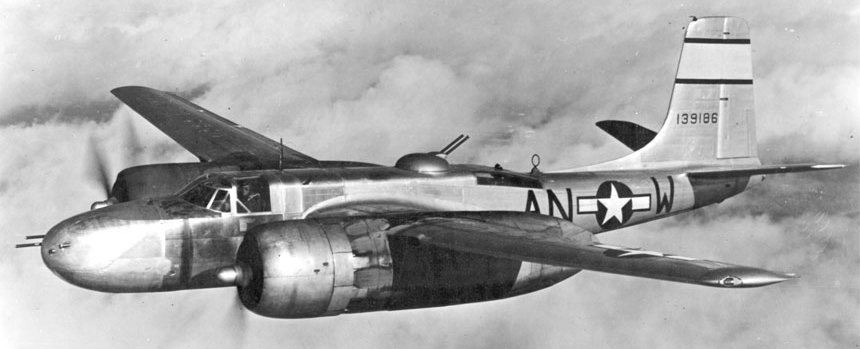



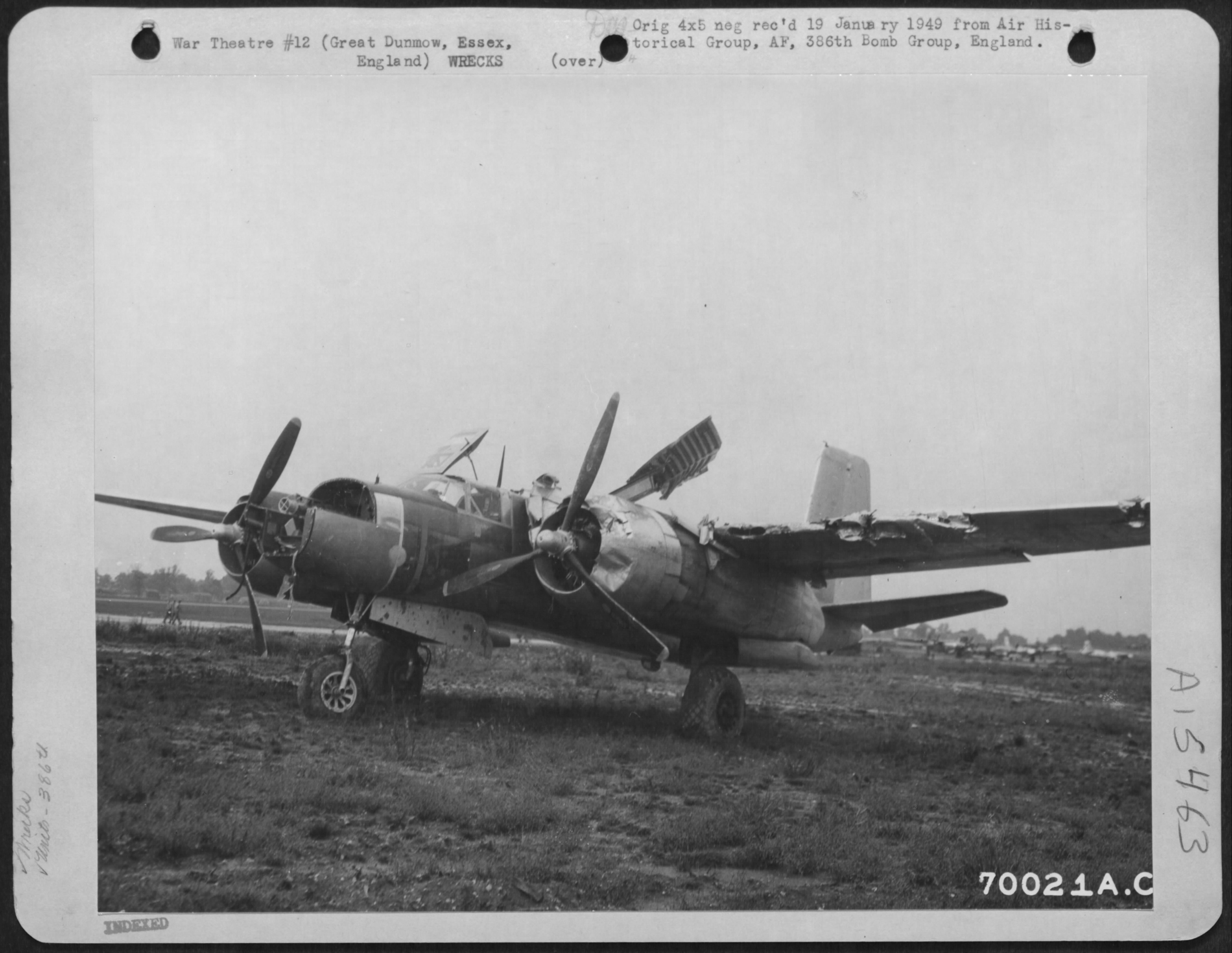
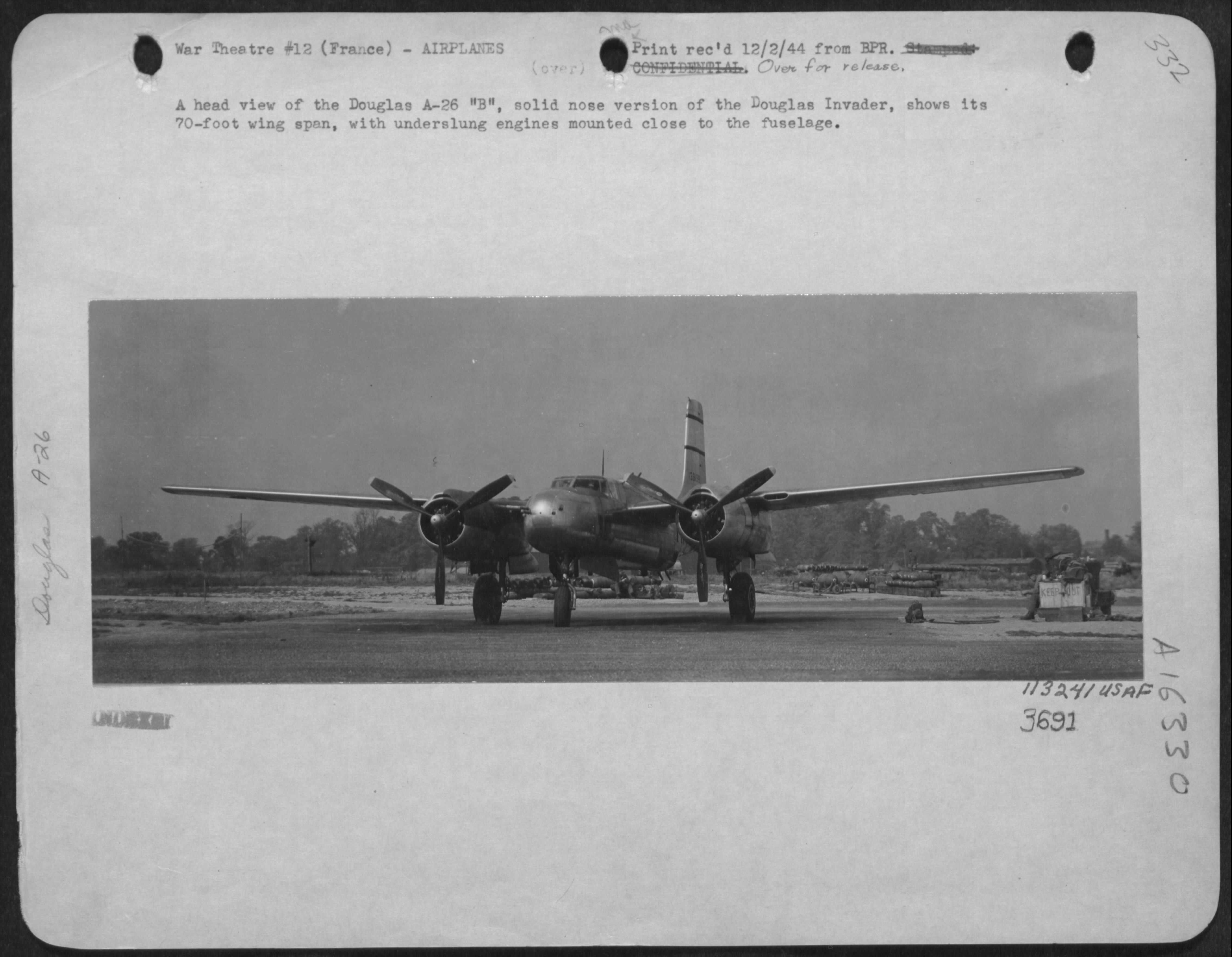
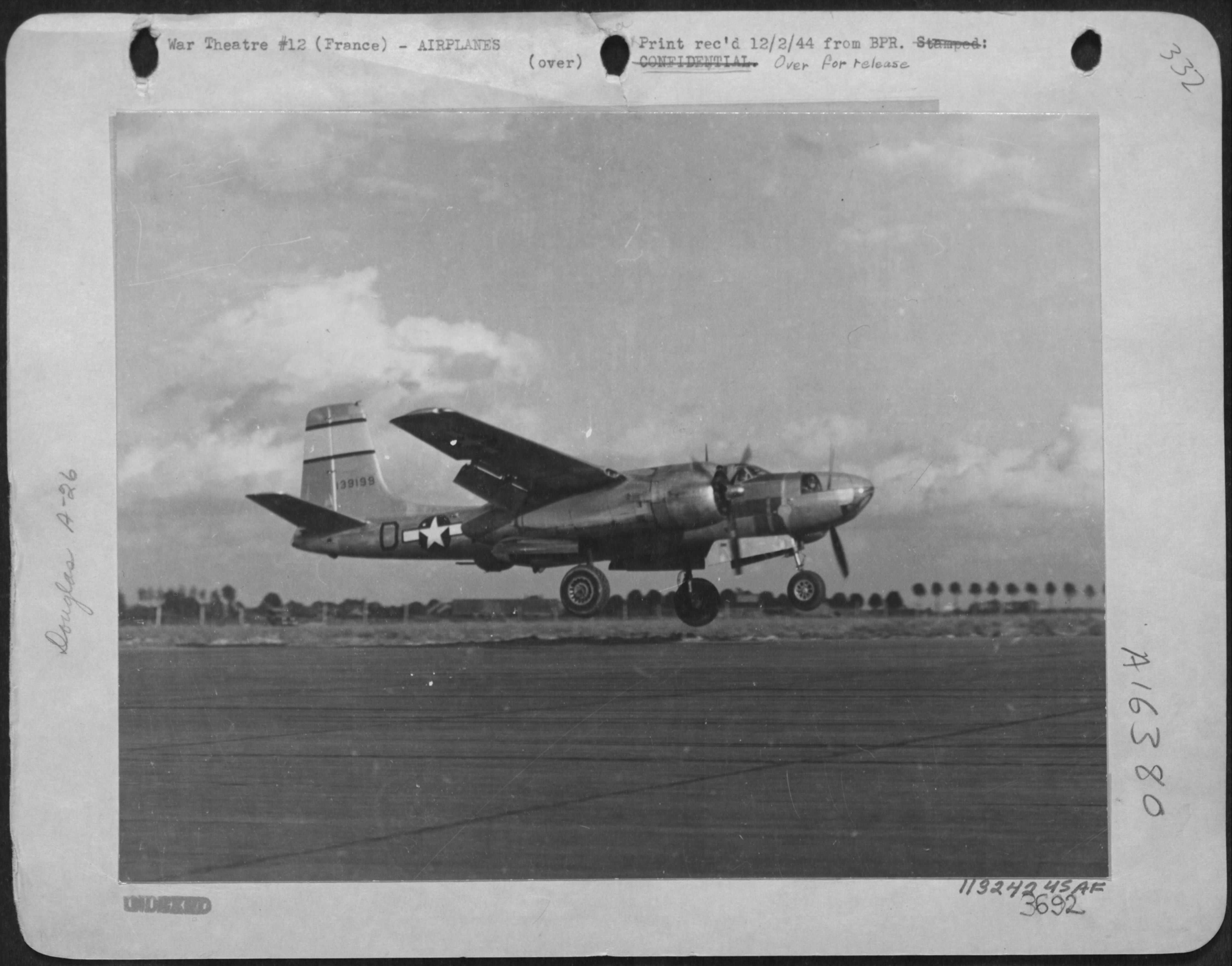


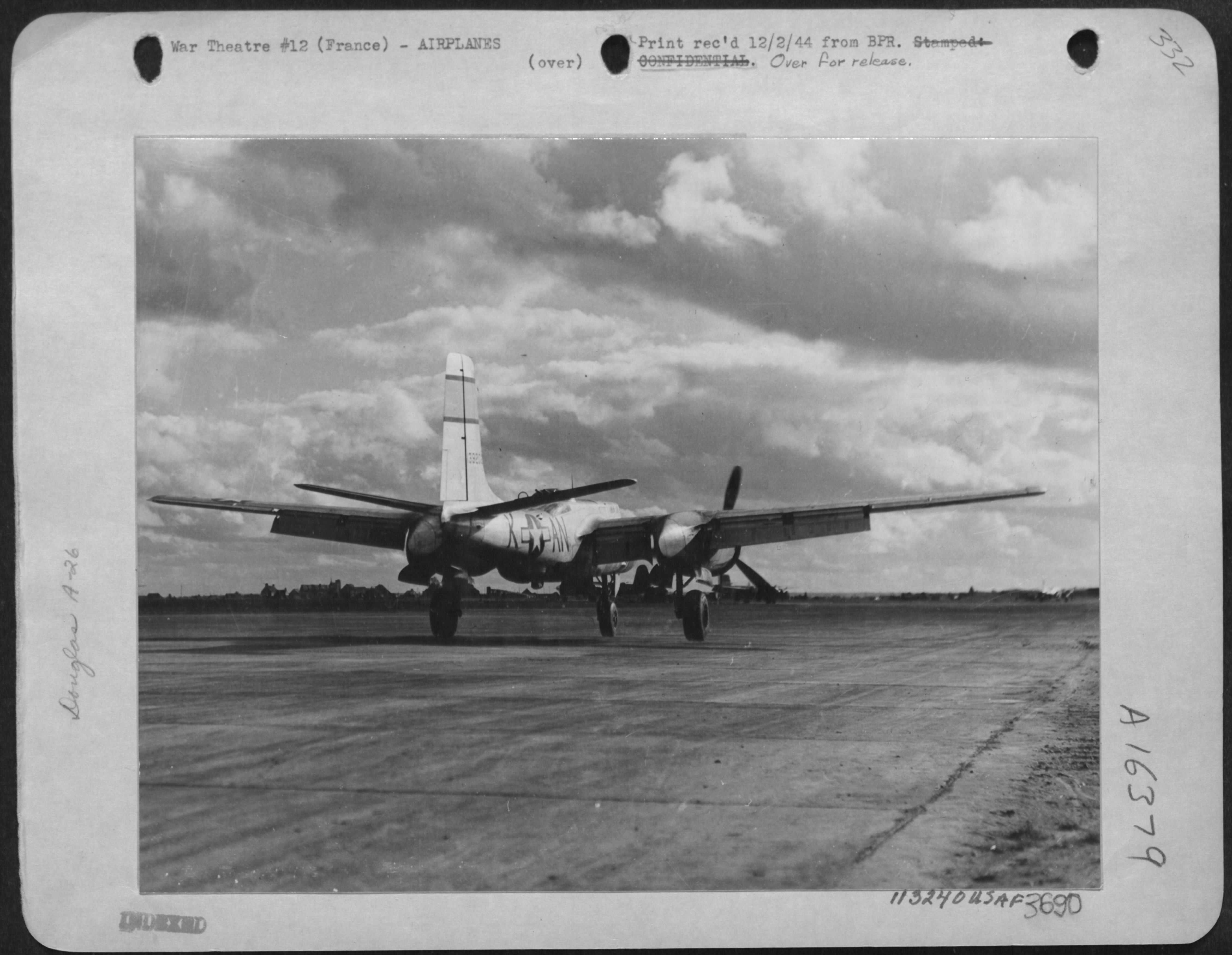
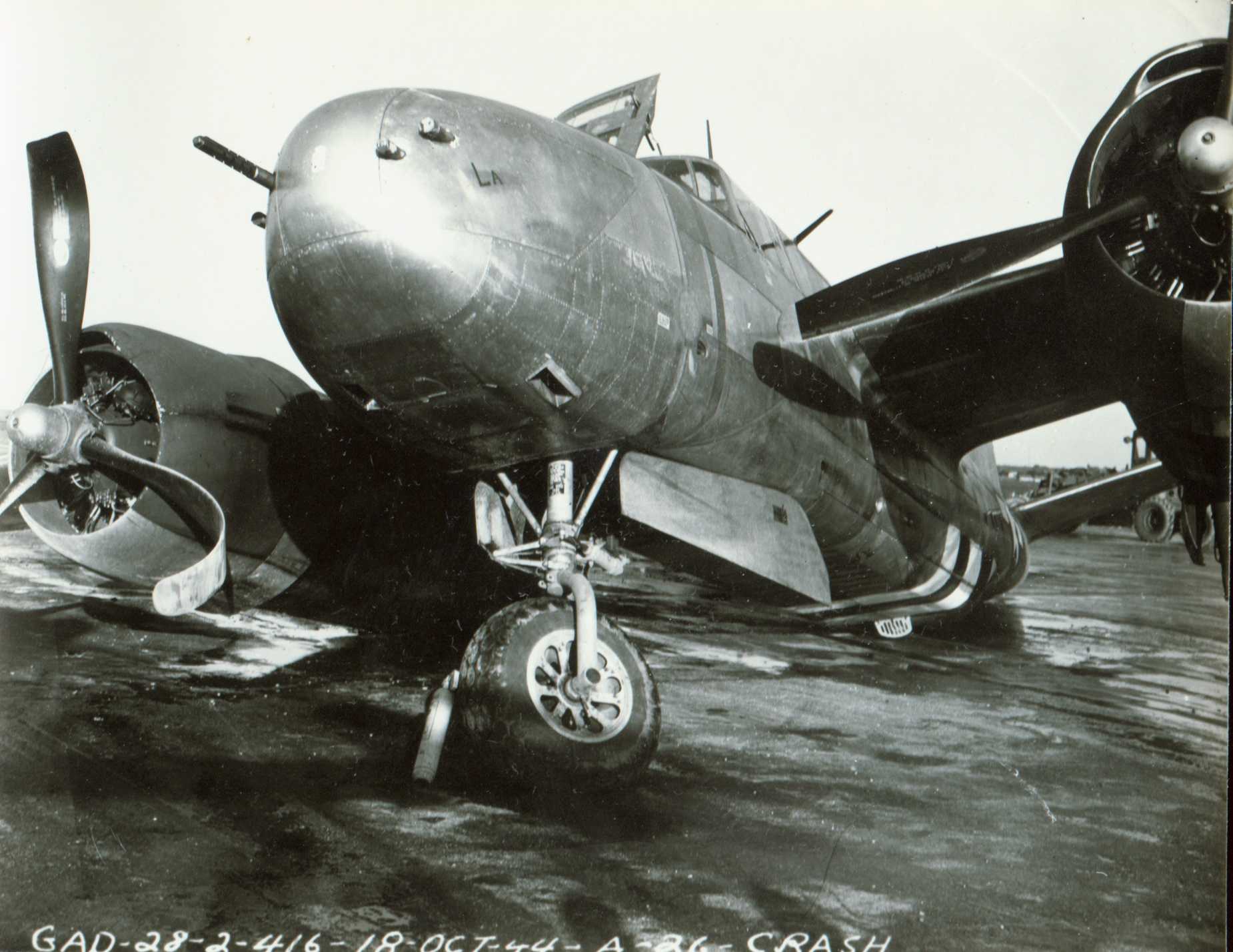


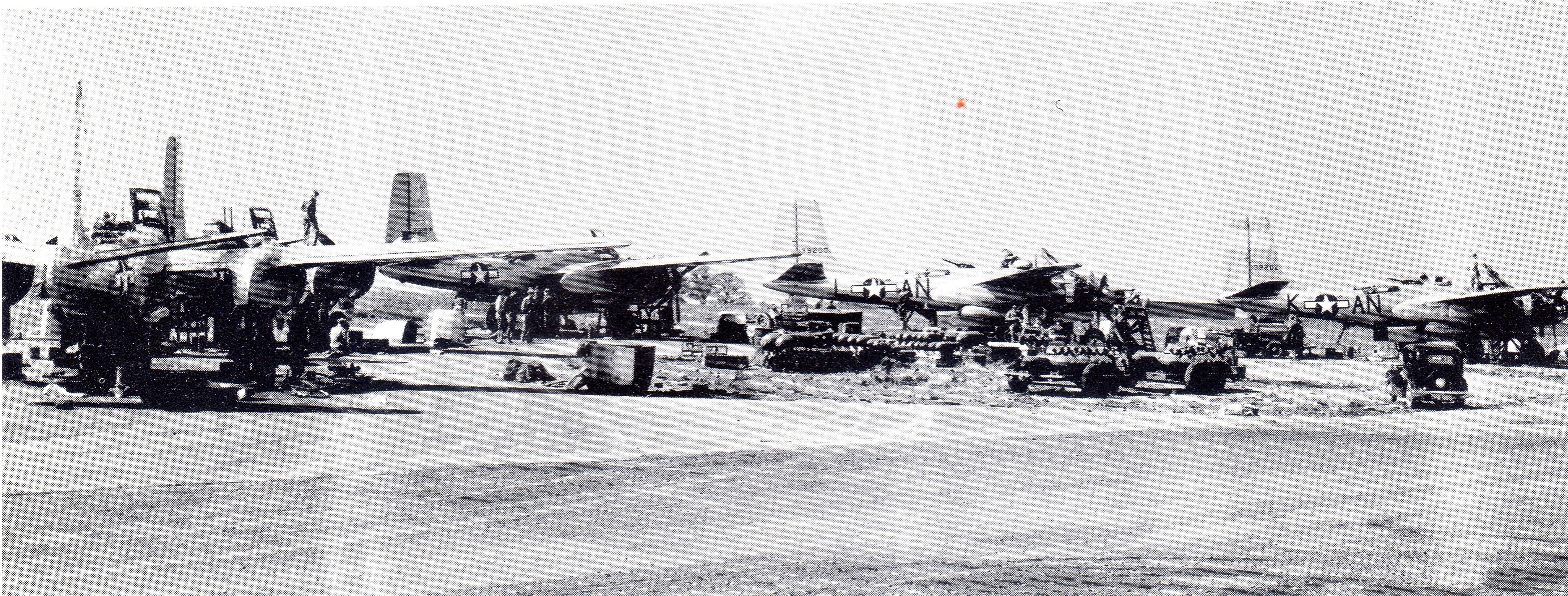
See Also:
A-26 ETO Combat Evaluation Historical Summary
A-26 ETO Combat Evaluation Personnel
A-26 ETO Combat Evaluation Evaluation Mission pages:
Evaluation Mission # 1 (386th BG #269) -- 6 September 1944 -- Brest, France
Evaluation Mission # 2 (386th BG #272) -- 10 September 1944 -- Custine, France
Evaluation Mission # 3 (386th BG #274) -- 11 September 1944 -- Metz, France
Evaluation Mission # 4 (386th BG #276) -- 11 September 1944 -- Leeuwarden, Holland
Evaluation Mission # 5 (386th BG #277) -- 12 September 1944 -- Scheld, Germany
Evaluation Mission # 6 (386th BG #279) -- 14 September 1944 -- Brest, France
Evaluation Mission # 7 (386th BG #280) -- 16 September 1944 -- Bergen-op-Zoom, Holland
Evaluation Mission # 8 (386th BG #282) -- 19 September 1944 -- Duren, Germany
A-26 ETO Combat Evaluation Sources and References